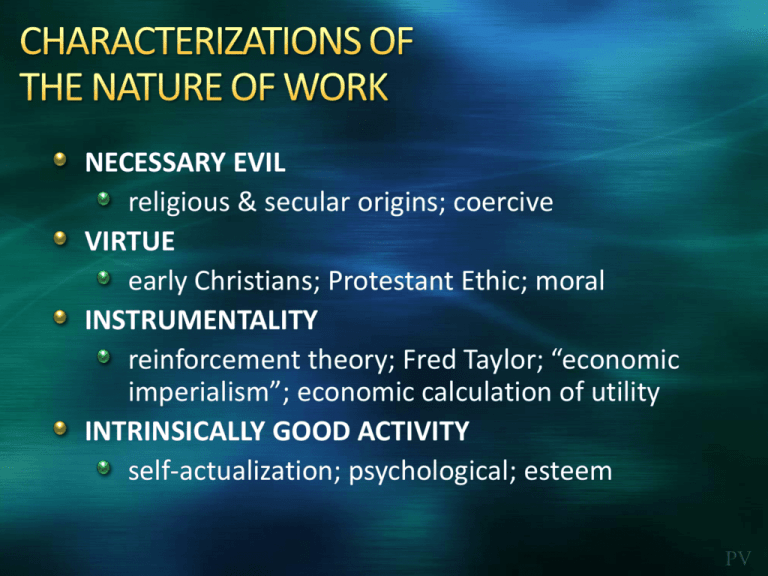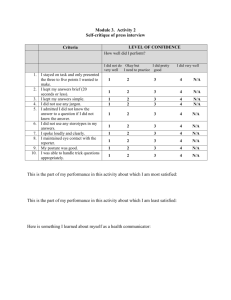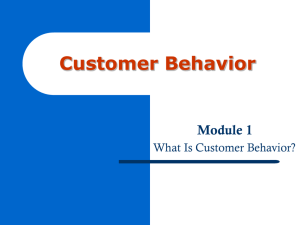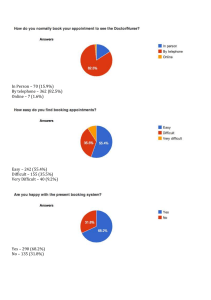I. Values & Attitudes
advertisement

NECESSARY EVIL religious & secular origins; coercive VIRTUE early Christians; Protestant Ethic; moral INSTRUMENTALITY reinforcement theory; Fred Taylor; “economic imperialism”; economic calculation of utility INTRINSICALLY GOOD ACTIVITY self-actualization; psychological; esteem PV Values early socialization stable more broad hard to change form basis of attitudes Attitudes encounter driven less stable specific to “attitude object” reflect values; often combination of multiple values A. Affective • expressed evaluation of the object • How one feels B. Behavioral • expressed intention or actual doing • What one does or intends to do C. Cognitive • expressed beliefs about the object • What one thinks or believes PV V a l u e s Attitude Intention Perceived Subjective Norms Perceived Behavioral Control Contingencies B e h a v i o r Balance Theory people desire to maintain balanced relationships involving others and attitude objects P-O-X relations O P Cognitive Consistency Theory people wish to maintain consistent beliefs about an attitude object X unqualified good/bad; no shades of gray PV Attitude - Behavior inconsistency creates psychological TENSION When we maintain an original attitude and behave inconsistent with it Strength of devotion to the idea/attitude Desire to preserve one’s positive self-image When we invest effort or resources in a decision it becomes difficult to change the direction of our behavior Escalation of commitment Penance Severity of initiation PV Festinger & Carlsmith (1957) boring task attitude questionnaire (time 1) Oops! $1 $20 attitude questionnaire (time 2) PV Handicapped Access Identified students who strongly advocate handicapped access counter attitudinal vs. neutral essay offered opportunity to help by volunteering to escort a handicapped student on campus Sexual Discussion Group (1960) women’s campus recite passages from romance vs. explicit erotic novel offered opportunity to return to next group meeting as a full member Decisions to join groups or organizations are susceptible to dissonance effects severity of initiation produces greater desire to remain member of the group Fraternities, sororities, elite groups, cults electing to attend ASU Purchasing Behavior buying a car or computer for example, produces a desire to avoid ‘buyer’s remorse’ and to confirm the wisdom of your decision PV Likelihood of attitude change is influenced by the extremity of the attitude and the degree of ego involvement in the attitude Initial position Latitude of Acceptance Latitude of Rejection Latitude of Acceptance narrower when ego involvement is high; tolerance of diverse views is constrained more similar views are ‘assimilated’ and views in the rejection area are seen as more different than they actually are contrasted. PV Top Occupations in Job Satisfaction Bottom Occupations in Job Satisfaction Rank, Occupations, Mean Score, % Very Satisfied • • • • • • • • • • • • 1 Clergy 3.79 87.2 2 Physical Therapists 3.72 78.1 3 Firefighters 3.67 80.1 4 Education Administrators 3.62 68.4 5 Painter, Sculptors, Related 3.62 67.3 6 Teachers 3.61 69.2 7 Authors 3.61 74.2 8 Psychologists 3.59 66.9 9 Special Education Teachers 3.59 70.1 10 Operating Engineers 3.56 64.1 11 Office Supervisors 3.55 60.8 12 Security & Financial Services Salespersons 3.55 65.4 • • • • • • • • • • • • 1 Roofers 2.84 25.3 2 Waiters/Servers 2.85 27.0 3 Laborers, Except Construction 2.86 21.4 4 Bartenders 2.88 26.4 5 Hand Packers and Packagers 2.88 23.7 6 Freight, Stock, & Material Handlers 2.91 25.8 7 Apparel Clothing Salespersons 2.93 23.9 8 Cashiers 2.94 25.0 9 Food Preparers, Misc. 2.95 23.6 10 Expediters 2.97 37.0 11 Butchers & Meat Cutters 2.97 31.8 12 Furniture/Home Furnishing Salespersons 2.99 25.2 Mean Score: Runs from 1 for someone who is Very Dissatisfied to 4 for someone who is Very Satisfied. Job Satisfaction: On the whole, how satisfied are you with the work you do—would you say you are very satisfied, moderately satisfied, a little dissatisfied, or very dissatisfied? The Society for Human Resource Management (SHRM), an international association of HR professionals, found 80 percent of workers liked their jobs. Sirota Consulting, a New York-based attitude research company, reported a satisfaction rate of 76 percent. Harris Interactive is one of several companies reporting less positive findings. A market research firm, it found 41 per cent disliked their jobs. The Conference Board, a management advisory organization, placed the satisfied figure at 50 percent in one poll and much lower in another. Conducted for the Conference Board by research agency TNS, it said 25 percent of American workers admitted they are just "showing up for a paycheck." • Different factors more important for each but look at the top 10 for common causes. • Men & women have similar rankings; promotion and wages more important for men – work-life balance, coworkers, flex time for women. • For workers under 35, supervisor and coworkers are more important than other age groups; for over 55, job security and workload. Of importance since Hawthorne Is ‘the job’ one idea in the minds of people? Global ( - - ) versus Facet satisfaction Five core Facets of the job pay advancement opportunities the work itself coworkers supervisor Other Facets may apply to different jobs based on industry (healthcare; hospitality) PV Satisfaction Performance Performance Satisfaction Bi-directional causality Third variable account r=.30 Performance Satisfaction Organizational Citizenship Behaviors PV Compliance complies with rules follows policy arrives on time does not abuse breaks responsibly consumes resources courteous Altruism offers assistance mentors others arrives early, stays late assumes additional roles trustworthy takes initiative fosters morale In spite of job dissatisfaction, people remain Organizational commitment is a stabilizing force that acts to maintain behavioral direction when expectancy/equity conditions are not met What mechanisms operate to sustain behavior in the face of disappointment? Parents don’t easily give up on children Consumers remain loyal to brands despite evidence Employees don’t quit out of hand when the employment relationship erodes Continuance commitment the desire to remain with the organization based on the costs of leaving or a sense that available comparable alternatives are limited - as an instrumental calculation; investments & side-bets Normative commitment the desire to stay with an organization based on a sense of duty, loyalty or moral obligation - as a moral obligation; reciprocity Affective commitment the emotional attachment a person feels for the organization because they see their goals and values to be congruent with that of the organization - as an attitude; social identity PV Active Passive Destructive EXIT NEGLECT Constructive VOICE LOYALTY The Ages of Satisfaction Less than two out of every five workers under the age of 25 are satisfied with their jobs. This segment of the population has the lowest level of satisfaction and the lowest level ever recorded in the nearly 20-year history of this survey. Workers age 45-54 expressed the second lowest level of satisfaction with less than 45 percent content with their current job. At the other end of the scale are workers 55-64 and 65 and over. Nearly half of all workers in these age groups are satisfied with their employment situation. Location, Location, Location Less than 41 percent of householders in the Middle Atlantic states (NY, NJ and PA) claim to be satisfied with their current job. The West South Central region (TX, OK, AR, LA) is home to the second least satisfied workforce. Only 43 percent of workers say they are satisfied with their overall employment situation. The most content workers tend to reside in the Mountain states (MT, ID, WY, NV, UT, CO, AZ, NM). Here, 56 percent of all workers say they are satisfied with their job. Money Does Buy Some Satisfaction • As expected, the lowest level of job satisfaction is exhibited among workers earning $15,000 or less per year. • Workers whose earnings exceed $50,000 per year, at 52 percent, are the most satisfied with their employment situation. What About the Job? Employees rated bonus plans and promotion policies as the least satisfactory benefits of employment, with less than 23 percent claiming they are satisfied with their company's policies. Educational and job training programs as well as non-monetary reward/recognition and performance review processes did not fare well either. Less than 30 percent of respondents claim to be satisfied with these job aspects. Less than 36 percent of employees expressed contentment with their workload, work/life balance, communication channels and potential for growth. At the other end of the scale, more than 56 percent of workers are satisfied with their commute and coworkers as well as interest in their work.





